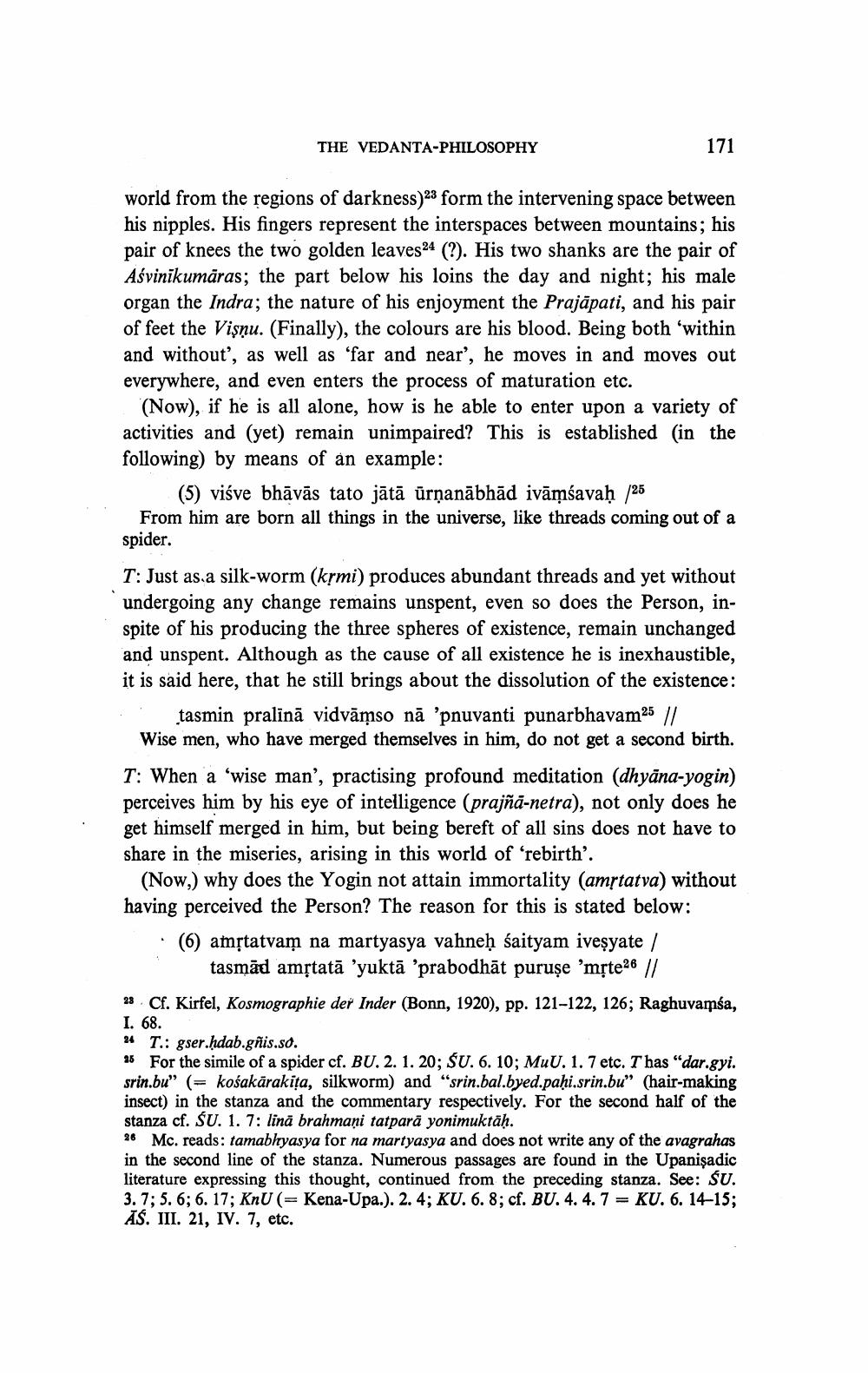Book Title: Vedanta Philosophy Described By Bhavya In His Madhyamaka Hrdaya Author(s): V V Gokhale Publisher: V V Gokhale View full book textPage 7
________________ THE VEDANTA-PHILOSOPHY 171 world from the regions of darkness)23 form the intervening space between his nipples. His fingers represent the interspaces between mountains; his pair of knees the two golden leaves 24 (?). His two shanks are the pair of Aśvinikumāras; the part below his loins the day and night; his male organ the Indra; the nature of his enjoyment the Prajapati, and his pair of feet the Vişnu. (Finally), the colours are his blood. Being both 'within and without', as well as 'far and near', he moves in and moves out everywhere, and even enters the process of maturation etc. (Now), if he is all alone, how is he able to enter upon a variety of activities and (yet) remain unimpaired? This is established (in the following) by means of an example: (5) viśve bhāvās tato jātā ūrṇanābhād ivāmśavaḥ /25 From him are born all things in the universe, like threads coming out of a spider. T: Just as a silk-worm (krmi) produces abundant threads and yet without undergoing any change remains unspent, even so does the Person, inspite of his producing the three spheres of existence, remain unchanged and unspent. Although as the cause of all existence he is inexhaustible, it is said here, that he still brings about the dissolution of the existence: tasmin pralinā vidvāmso nā 'pnuvanti punarbhavam 25 // Wise men, who have merged themselves in him, do not get a second birth. T: When a 'wise man', practising profound meditation (dhyana-yogin) perceives him by his eye of intelligence (prajñā-netra), not only does he get himself merged in him, but being bereft of all sins does not have to share in the miseries, arising in this world of 'rebirth'. (Now,) why does the Yogin not attain immortality (amṛtatva) without having perceived the Person? The reason for this is stated below: (6) amṛtatvam na martyasya vahneḥ śaityam iveşyate / tasmad amṛtatā 'yuktā 'prabodhāt puruşe 'mṛte26 || 28 Cf. Kirfel, Kosmographie der Inder (Bonn, 1920), pp. 121-122, 126; Raghuvamsa, I. 68. 24 T.: gser.ḥdab.gñis.so. 25 For the simile of a spider cf. BU. 2. 1. 20; SU. 6. 10; MuU. 1. 7 etc. Thas "dar.gyi. srin.bu" (= kośakārakiṭa, silkworm) and "srin.bal.byed.pahi.srin.bu" (hair-making insect) in the stanza and the commentary respectively. For the second half of the stanza cf. SU. 1. 7: lină brahmani tatpara yonimuktāḥ. 26 Mc. reads: tamabhyasya for na martyasya and does not write any of the avagrahas in the second line of the stanza. Numerous passages are found in the Upanisadic literature expressing this thought, continued from the preceding stanza. See: SU. 3. 7; 5. 6; 6. 17; KnU (= Kena-Upa.). 2. 4; KU. 6. 8; cf. BU. 4. 4. 7 KU. 6. 14-15; AS. III. 21, IV. 7, etc.Page Navigation
1 ... 5 6 7 8 9 10 11 12 13 14 15 16
